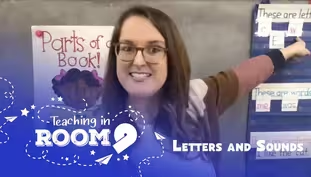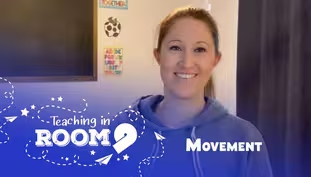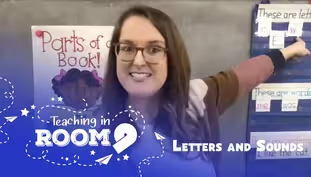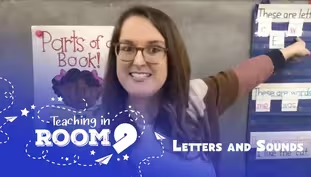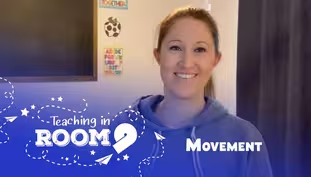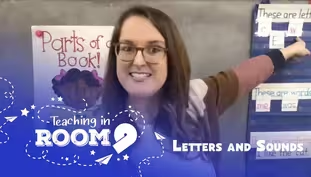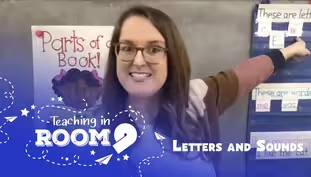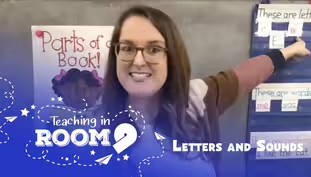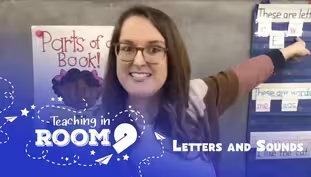Teaching in Room 9
Track and Field Movement | Movement
Special | 28m 54sVideo has Closed Captions
Students will learn a variety of different track & field events they can practice at home.
In this lesson, students will learn a variety of different track and field events they can practice at home to get their body up and moving! / Julia St. Louis, Mehlville School District, Rogers Elementary School
Problems playing video? | Closed Captioning Feedback
Problems playing video? | Closed Captioning Feedback
Teaching in Room 9 is a local public television program presented by Nine PBS
Teaching in Room 9
Track and Field Movement | Movement
Special | 28m 54sVideo has Closed Captions
In this lesson, students will learn a variety of different track and field events they can practice at home to get their body up and moving! / Julia St. Louis, Mehlville School District, Rogers Elementary School
Problems playing video? | Closed Captioning Feedback
How to Watch Teaching in Room 9
Teaching in Room 9 is available to stream on pbs.org and the free PBS App, available on iPhone, Apple TV, Android TV, Android smartphones, Amazon Fire TV, Amazon Fire Tablet, Roku, Samsung Smart TV, and Vizio.
More from This Collection
A collection of Arts lessons from Teaching In Room 9.
Phonemic Awareness - Consonant Digraphs | Letters and Sounds
Video has Closed Captions
Anchor chart, whole brain teaching, and songs in order to practice consonant digraphs. (29m 54s)
Rainforest Animal Movement | Movement
Video has Closed Captions
Campers will get their bodies moving by acting like animals who live in the rainforest. (27m 3s)
Phonemic Awareness-Changing Sounds in Words|Letters & Sounds
Video has Closed Captions
Julia starts by reviewing what we have previously learned by singing review vowel songs. (29m 50s)
Phonemic Awareness - Vowel Sounds | Letters and Sounds
Video has Closed Captions
Using an anchor chart and songs to distinguish between long and short vowel words. (29m 26s)
Phonemic Awareness- Segmenting Sounds | Letters and Sounds
Video has Closed Captions
In this lesson Julia uses an anchor chart & songs to discuss segmenting sounds in words. (29m 46s)
Movement Mission to Space | Movement
Video has Closed Captions
Campers will get their body moving by doing various exercises to complete a space mission. (27m 56s)
Phonemic Awareness - Rhyming Words | Letters and Sounds
Video has Closed Captions
In this lesson, Julia uses an anchor chart and songs to discuss rhyming words. (29m 19s)
Decoding Using Spelling Patterns 2 | Letters and Sounds
Video has Closed Captions
In this lesson, Julia reviews previously learned skills. (29m 15s)
Decoding Using Spelling Patterns 1 | Letters and Sounds
Video has Closed Captions
In this lesson, Julia reviews previously learned skills. (29m 30s)
Decoding Using Syllables 2 | Letters and Sounds
Video has Closed Captions
Using anchor charts and songs to practice using syllable rules to decode new words (29m 44s)
Decoding Using Syllables 1 | Letters and Sounds
Video has Closed Captions
Julia uses anchor charts and a song to practice using syllable rules to decode new words. (29m 35s)
Consonant Blends | Letters and Sounds
Video has Closed Captions
Using an anchor chart, whole brain teaching, and a song to practice consonant blends. (29m 34s)
Providing Support for PBS.org
Learn Moreabout PBS online sponsorship(happy music) - Hi, everybody.
And welcome back to Room 9, our region's largest classroom.
My name is Mrs. St. Louis, and I'm a teacher at Rogers Elementary School in the Mehlville School District.
And we are located in South St. Louis County.
Today, I'm here to teach a movement lesson that's geared towards students of all ages.
So let's get ready to get moving.
Now, today we are going to be talking all about track and field events.
So that means we're gonna do a little bit of running.
We're gonna do a little bit of jumping, and we're gonna do a little bit of throwing.
But before we can do that and get started, we have to warm up and stretch our bodies.
That's always really important to make sure that we don't hurt our muscles that haven't been moving up until now.
So we're gonna begin by standing in a straddle.
That means my legs are far apart, right?
So my feet are definitely farther apart than my shoulders.
So if I went from my shoulders into a straight line down, my feet are further apart than that.
I'm gonna reach to one side, reaching as far down my leg as I can go, keeping my legs straight.
If I bend my knees, I'm not gonna get that stretch at the back of my legs that I should be feeling.
Now, if you can't make it all the way down to your feet or the floor, that's okay.
Go down to your knee.
And the next time we stretch, as we keep going, you can go just a little bit farther, all right?
It's okay if right off the bat we can't get all the way there.
So come back up, and we're going to go down the other leg, stretching again as far as you can.
And if you can't make it all the way down, that's okay.
Again, we want to keep our legs straight, feel that stretch at the back of your leg.
And let's reach forward.
We're gonna try and see if we can touch the floor.
If you can't touch the floor, just go as far as you can.
And each time we do this move, we'll practice getting just a little bit farther.
And come back up.
Whew.
Definitely feeling that stretch in your legs, aren't ya?
All right, now we're going to stretch our legs a little bit more.
We're definitely using our legs a lot today, so we want to make sure they're ready.
So now what I'm gonna do is I'm gonna stretch my hamstrings.
So how I do that is I might need a wall or a chair or something to help me balance.
So I'm gonna hold on to the wall with one hand.
My leg that is farthest away from the hand that's holding on, I'm going to bring up my foot and just hold the back, holding onto my ankle, just stretching, just gently holding it.
And I'm gonna switch.
So I'm gonna turn around.
So again, I can help with that balance, holding onto that wall or that chair, maybe the side of a couch, just holding my foot back, getting a good stretch.
All right, now, because we are going to be doing some throwing today, we do want want to stretch out our arms.
So I'm gonna start with some little baby arm circles going forwards, and I'm gonna make 'em bigger, stretching out the shoulders.
And I'm gonna make it smaller.
And this here is Winnie.
She loves to do some good track and field.
Jumping, running, they're all her favorites, and make those arm circles backwards bigger.
Very good.
And can you cross them in front just like a giant pair of scissors.
Oh.
Definitely get them ready and warmed up, feeling good.
All right, now we're gonna begin to warm up our legs a little bit more, getting them ready to do some bigger exercises.
So what we're going to do now is we're going to do some exercises where we're really working our hips.
We're gonna be doing some different jumps today and some different exercises that are gonna require our hips maybe to move in different ways than they've moved before.
So I'm gonna start by bringing my knee up in front of me.
Ooh, doing it slow is a little hard.
And then I'm gonna bring it out to the side and down.
So again, bringing my knee up in front, out to the side, and down.
Let's do that together.
We're gonna do it a little faster, though, so we don't have to balance as much.
Bringing it up, out, down, up, out, down.
Getting those hips moving.
Up, out, down, up, out, down, whew.
A little extra balance there, huh?
Up, out, down.
Let's do four more.
Up, out, down.
Three.
Up, out, down.
Two.
Up, out, down.
Last one.
Up, out, down.
Now we're gonna do it backwards.
So now I'm gonna go up, in, down, up, in, down.
So up, in, down, right?
Up to the side, turning that knee out, and coming to the front and back down.
Up, in, down, up, in, down, up, in, down, up in down.
Four more.
Up, in, down, up, in, down, up, in, down, last one, up, in, down.
Right, kind of did an extra there.
That's okay.
All right, next up.
(Winnie rustles) Ooh, we've got toys now.
All right, next up, boys and girls, we're gonna pick up the pace, getting our bodies ready to do some more vigorous running, getting that heart rate up.
So to start, bring your knees up in front of you, trying to get them as high as you can, just going slow at first, getting our body used to the motion.
All right, for 20 seconds, we're gonna run fast, keeping that same motion, getting our knees up in front.
Are you ready?
And let's go.
One, two, three, four, five, six, seven eight, nine, 10, 12, 13, 14, 15, 16, 17, 18, 19, 20.
Whoo.
How do you feel?
Take a deep breath in and out.
(breathes deeply) In and out.
All right, this time, we're going to be doing kind of the same motion, but in reverse.
So I'm gonna be bringing my feet behind me.
Trying to get the heels of my feet to touch my bottom.
So let's start slow.
Slowly going.
(toy squeaks) All right, ready to pick up the pace for 20 seconds?
(toy thuds) And let's go.
One, two, three, four, five, six, seven, eight, nine, 10, 11, 12, 13, 14, 15, 16, 17, 18, 19, 20.
Whew, I think we're warmed up and ready.
What do you think?
Awesome.
All right.
So we're gonna start with our very first track and field event.
So the first one we're gonna be starting with is hurdles.
Now, you may have seen this before.
Hurdles are when runners are running, and then they come to almost what looks like a little box in front of them, right?
It goes up and it crosses in the middle, and the runners have to hurdle over them and then keep running.
Then there's another one they have to hurdle over and keep running.
Now, I know that we don't have hurdles at home.
I sure don't.
So we can use imaginary hurdles, right?
Thinking about something imaginary being in front of us and trying to jump over it.
Now, the really good thing about them being imaginary is that we won't trip over them.
So sometimes that happens.
And we can choose the height of our own hurdles, right?
We get to pick how high they are and practice.
Now, here's where you can challenge yourself.
If you want to see if you really can jump over something.
What you can do is you can find a box or a pillow or stack a couple books, right?
Practice hurdling over them.
If you're able to hurdle over them, stack it a little bit higher, but again, that's not necessary.
But to practice for today, since you can't see my imaginary box, I'm gonna use our real one, just so we can really help to see what I'm doing today.
Winnie's gonna check it out.
So, we're going to start slow.
So I'm gonna do some running in place just because we don't have a lot of spaces in our homes, right?
Again, later if you want to go outside and practice this outside, feel free to do so.
It gives you more space.
But just for the purposes of in-home, we are gonna be running in place.
Then you choose which foot you really want to put over, thinking about it, you might have to walk through and think, "Hmm, which foot is gonna go over first?"
Right, then I'm gonna have to see, "Hmm, which one feels the best," right?
So I'm going to put my left foot over first.
So I'm gonna be running, running.
If you're like me, you might have to hurdle over a dog.
I'm going to step with my planting foot.
My foot and back is the one that's gonna go over.
So I'm gonna push it over and go, right?
Now, as I continue to practice, I can pick up my pace, right?
So I can be running, running, running.
Comes to my hurdle again.
Go over.
Whoo.
Right?
Now, if you really feel into it, put a couple in a row, right?
So I can be running, running, hurdle.
Run, run, run, hurdle.
Okay, so be practicing that.
Let's see if we can do, let's do five more hurdles.
I'm running, running, running, hurdle.
Run, run, I'm gonna turn around so you can still see me run.
Hurdle, run, run, three more.
Run, get to the end of that race.
Hurdle, run, run, run.
Hurdle.
Last hurdle.
Run, run, run.
Hurdle.
Don't stop there.
We gotta make it all the way to the finish line.
Run, run, run, and you did it.
Woo, you made it all the way to the finish line.
Excellent job.
Give yourself a pat on the back, take a deep breath.
(breathes deeply) It's always important, right, to breathe as we are exercising.
Sometimes when we exercise, we forget to breathe.
I know sometimes I find that I'm holding my breath.
That's not gonna help you to get longer and longer distances or to really practice things like track and field.
You really have to make sure that you're breathing the entire time.
Super important.
All right, so I don't know where this came from.
We have done some hurdles.
Now let's do some sprints.
So when we're doing talking about track and field, right?
The shorter races are called sprints.
They're really short distances.
And the purpose of a sprint is to run as fast as you possibly can to the finish line.
So because we don't have a start to finish line here, we're just gonna run for a specific amount of time as fast as we can.
But if you ever have the opportunity to go outside, mark a starting point, mark an ending point, and practice running as fast as you can from one end to the other.
But we're gonna start off slow with a short, short sprint.
All right, we're gonna do 10 seconds running as fast as you can.
So what you can do, is you run in place.
You could run in a circle if you wanted to.
You could run back and forth, whatever works best for you.
I'm gonna run in place, though, are you ready?
10 seconds as fast as you possibly can.
Remember, as you're running, don't leave your arms down by your side, right?
Don't keep your arms super stiff.
You want to keep them almost in this L position next to you, and you want to keep your hands not really tight in a fist, but not also flat out.
I like to keep mine kind of closed a little bit, right?
They're gonna help with that motion, help me get as fast as possible.
But if I kept my arms right down by my side, I wouldn't be able to run my fastest.
Are you ready?
10 seconds.
On your mark, get set, go.
1, 2, 3, 4, 5, 6, 7, 8, 9, 10, stop.
It's definitely a fast sprint, but working our way up to longer times is gonna help us to get faster.
If I started off with a whole minute as fast as I could, by the end, I'm not gonna be as fast as I possibly can.
So work your way up.
Start with 10 seconds, then move to 15, then 20, and so on.
Building yourself up to get faster and faster for longer sprint distances.
But let's try 15 seconds.
I think we're ready for it.
Are you ready?
All right.
One, ready, set, go.
1, 2, 3, 4, 5, 6, 7, 8, 9, 10, 11, 12, 13, 14, 15, and stop.
Whew, I'm definitely feeling it.
Whew, running, getting the heart rate up really, really fast.
When it comes to sprints, the goal is to be running as fast as you possibly can to the end, right?
We don't really have to save our energy because we know that race is gonna be over really, really soon.
But I think we've got it in us for one more sprint.
What do you think?
I think so too.
This time, we're gonna try for 20 whole seconds.
Are you ready?
All right.
20 seconds.
Three, two, one, go!
1, 2, 3, 4, 5, 6, 7, 8, 9, 10, 11, 12, 13, 14, 15, 16, 17, 18, 19, 20.
Whew.
Excellent job.
Way to rock it!
I think now's a really good time for a drink break.
Don't forget that as we're working so, so hard, stop and get a drink of water.
If you ever need a drink of water, stop and get a drink.
But remember, don't guzzle down your entire water bottle.
That might make him not feel so good.
So just small sips as we take a short little break, then we'll be ready to get onto our next set of track and field exercises.
All right, we are back, and we are ready for some more track and field exercises.
So next up, we're gonna be practicing some throwing.
Ooh, gotta move my hurdle out of the way, So what we're going to be doing next is called the shot put.
Now, the shot put is when we are throwing a ball as far as we possibly can.
Now, typically, these are really heavy balls.
But I'm inside my home as you probably are too.
And I know I probably shouldn't be throwing things.
So I'm gonna be practicing with an imaginary ball.
If you have the chance to practice this outside, you could use something like a tennis ball, maybe like one of those really small basketballs, but nothing too big.
A really big basketball, a soccer ball, a volleyball, those are gonna be too big.
This ball is about the size of a tennis ball, okay?
So that's what I want you to imagine.
A ball that's gonna fit perfectly into your hands.
And what we're gonna do is we're gonna hold that ball right next to our neck, just underneath our chin.
Okay, so I'm gonna use my arm.
It's going to be straight out with my elbow.
And I'm gonna hold it underneath my chin.
Now, the goal, again, is to launch this as far as I possibly can, okay?
So part of the reason that I'm gonna have to throw it, I'm gonna have to use my arm to push that ball out.
Also gonna have to use my legs though.
My legs are gonna help give me power to launch that ball.
So first thing I need you to do is I need you to think about which hand are you gonna throw that ball with.
Hmm, I think I'm gonna use my right hand.
Okay, so I'm gonna think my right hand is right here, holding that imaginary ball.
So I'm gonna put like opposite leg in front.
My left leg's gonna go in front.
That's gonna be the leg that I'm gonna push off with as I launch that ball.
So I'm gonna stand with one leg in front.
My left leg in front, and my right leg behind, okay?
And so now, let's go through it slow, okay.
We're gonna lean back on our back leg, on our right leg.
And I'm going to push off of my left leg in front.
As the same time I'm pushing off, my arm is going to be launching forwards, okay?
Are you ready?
Okay, slow.
We're gonna go slow Lean back and push.
Very good, very good.
Again, you're trying to launch that ball as far as you can, right?
We're not throwing it.
So my arm isn't doing a throwing motion.
It's not going underneath.
I'm using my arm to push that ball off of my shoulder.
So again, ready, back, and push.
Whew, I think that time it went farther.
I think we're starting to get the hang of this.
What do you think?
Holding that ball there, leaning back, and push!
Whew, all right, stretch it out, stretch it out.
Might try the other side just to see how it feels.
You never know, it could be better.
All right, so again, my throwing arm back, other leg forward, and push.
Oh, that was not as good.
I'm gonna switch back to the other side.
Definitely not my best.
Holding it right next.
And push!
Whew.
It's going far.
Again, as you are outside, if you have multiple tennis balls or multiple balls, you could be practicing, just trying to get it farther and farther each time.
All right, let's do two more.
Holding it and push.
Ooh, I almost swung my arm there a little bit.
It takes some practice.
It takes some getting used to, doesn't it?
One more, holding it, and push.
Excellent job, boys and girls.
Whoop, feeling good.
All right, next up, we are going to practice the long jump.
Ooh.
The goal of this long jump is to have as long a jump as possible, right?
So here's how we're gonna practice.
With the long jump, you are running a short distance, then you're going to stop your foot right at a line.
I'm gonna use an imaginary line.
I'm going to launch off of that foot and jump as far as I possibly can, trying to land with both my feet together.
Now, we don't have a lot of space.
So again, I'm going to utilize the method where I run in place.
Then I'll take a step or two, then I'll jump.
Again, if you have more space, or you have the opportunity to practice this outside, you're gonna have longer and longer to jump.
This isn't perfect, but we're inside, and we're making it work.
So let's start slow motion.
I'm going to run, run, run.
Now I'm gonna step and jump as far as I possibly can.
Whew, probably stepped too far.
You couldn't even see me it was such a big jump.
So when I jump, I'm going to step, and I'm going to launch off my feet and jump as far as I possibly can.
Watch out for things above you or around you, okay?
(sighs) Let's try this again.
If you ever have the opportunity to do this outside with a piece of chalk, oh, mark a starting position, and every time you land, either yourself or a friend can mark where you end.
That way, as you continue to practice, you can practice jumping farther and farther distances.
So, all right, I'm running.
Uh oh, there's a dog in the way.
I want you to step and jump as far as I possibly can.
Again, each time trying to jump farther and farther.
Running as fast as I can, step, jump!
Whew, got to watch out, almost hit my head on the light.
Let's see if we can do two more long jumps.
Running, running, step, jump.
Whew, I think that was definitely farther.
I think I'm getting a hang of this.
What about you?
All right.
Last one.
Biggest jump that we've got.
Run, run, step, jump!
Whew, I think I'm getting farther.
What about you?
Yeah, definitely with more practice, I'm gonna be jumping huge distances.
All right, now, boys and girls, the last event that we are going to do is a long distance run.
We've done sprints, which are really short distances as fast as we can, but on the long distance run, we're not going to be giving it all we have.
With the long distance run, we want to run at a good pace, okay?
That means that we're slowing down.
Because again, we have to conserve all our energy for really long distance.
Some of you in school might have to practice running long distances.
Maybe you run a mile.
Maybe you run laps around your building in your PE class.
So you know that you can't (blows) pop off that starting point and run as fast as you possibly can, because in 5 or 10 seconds, you're gonna be tired, and you're gonna slow down, and you're not gonna be able to make it the whole way.
So what you have to do is you have to slow yourself down and run at a good pace.
So we're going to do a two minute run, two minutes.
I know that we can do this together.
So we're gonna go at a slow pace.
I'm starting us off just slowly running.
If you need to, you can run back and forth in your space.
You can run in circles in your space, okay?
Again, not going at a super big speed.
Just running, right?
If you ever have the chance, practice this in your neighborhood, right?
Running up and down the street, running around your block.
Remember, though, if you're running, and you're leaving your home or your backyard or the space outside of your building, you want to make sure that you always have an adult with you.
You should never be running alone, right?
Just as a safety precaution, always make sure that someone is with you.
That way, you can make sure that you're staying safe.
You don't accidentally get lost.
Always a good rule of thumb.
Run with a buddy.
Ooh, let's see, whoa, boys and girls.
We're rocking this.
We've gone 30 seconds.
Keep it up again.
If you're noticing that you're getting really, really tired, that means you should probably slow yourself down a little bit.
If you need to, take a break.
Stop, do a couple of deep breaths, take a minute, then start back up with this when you're ready.
Know it can be hard to run in place sometimes.
So run back and forth around in little circles, right?
Run around the kitchen.
Do whatever you need to do.
You are still going.
Let me check.
Oh, we are halfway.
Keep it up.
Keep it up.
Keep going.
Don't forget to breathe as you're running.
Breathe in.
It's important.
It's gonna help us keep going.
You've got this.
We're still running, still going.
Long distances definitely for me are the harder.
I like to just go give it all I got.
Long distances, they definitely take some thought, right?
I have to save my energy, can't give it all out.
You can do this.
Almost done.
20 seconds left, boys and girls.
Keep it up, keep it up.
All right, last 10 seconds.
We're gonna give it all we got.
Sprint to that finish line.
Are you ready?
Go!
Sprint all the way to that finish line.
Five, four, three, two, one.
And you did it.
Very good, boys and girls, take a deep breath in and out.
In and out.
If you're finding that it's really, really hard for you to breathe right now, your chest is getting stuck, put your hands on top of your head and breathe.
That helps to open your lungs up, helps to get you a bit more air as you're slowing yourself down.
Excellent job, boys and girls, with that long distance run.
Whoo.
That was two minutes.
So we've started with two minutes.
Practice that for a couple days, two minutes, running.
Then as the days go past, increase it to three, then four, then five.
And pretty soon, before you know it, you might be ready for 10 minutes.
It takes practice, and it takes a little bit of time and patience.
We're not gonna be able to go out there and run for 30 minutes in a row at the start.
We have to make sure that we set goals for ourselves, and making sure that those goals are obtainable is really important.
Something that we can achieve.
That's gonna help us make sure that we come back every single day and continue to practice.
All right, we're finished for today.
But let's do a little bit of some stretching to wind ourselves down.
We're gonna reach down and try to touch the floor.
Continuing to breathe, switching, reaching to one side.
Might have to bring your legs a little farther apart.
Reaching to the other side.
I'm gonna stand up.
I'm gonna bring one leg behind my other.
The leg that went back, I'm gonna take that arm, and I'm gonna reach over my side.
Stretching out the side of the muscles, and switch, bringing the other leg behind.
The leg that's behind, bringing that arm, reaching over.
Oh, boys and girls.
I am so happy and so proud of how well you did today.
Learning some new exercises in the track and field sport.
I hope that you come back next week as we explore some new movement activities.
Until then, remember the goal is 30 to 60 minutes of physical activity today.
Whether that means that you are out there walking, whether you are out there playing soccer, doing gymnastics, do something to get your body up and moving.
Get the blood flowing, get your heart pumping, and I'll see you guys again next week.
Bye, everyone, have an awesome week.
(happy music) - [Announcer] "Teaching in Room 9" is made possible with support of Bank of America, Dana Brown Charitable Trust, Emerson, and viewers like you.
Support for PBS provided by:
Teaching in Room 9 is a local public television program presented by Nine PBS
